An illegal cannabis grow site in San Bernardino County that CDFW’s Marijuana Enforcement Team raided in August 2025. In addition to cannabis plants, the photo shows a container of rodenticide; hosing used to illegally divert water; and western Joshua trees, which are currently the subject of a conservation effort in California. CDFW photo.
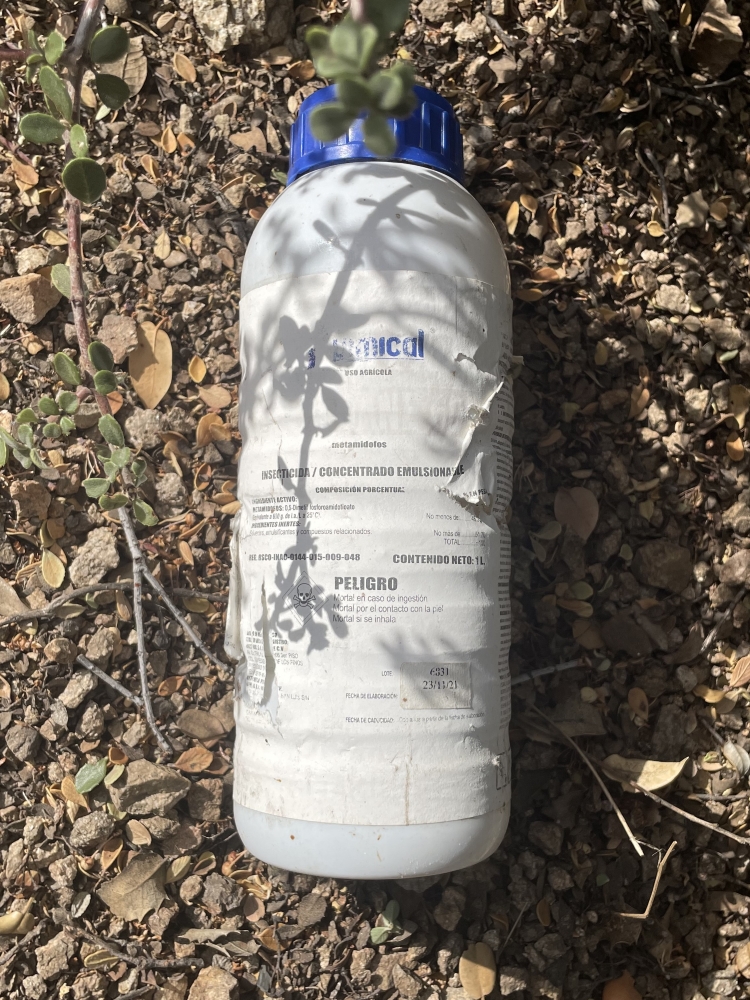 A container of methamidophos, a toxic organophosphate pesticide, found at an illegal cannabis grow site in San Bernardino County. CDFW photo.
A container of methamidophos, a toxic organophosphate pesticide, found at an illegal cannabis grow site in San Bernardino County. CDFW photo.
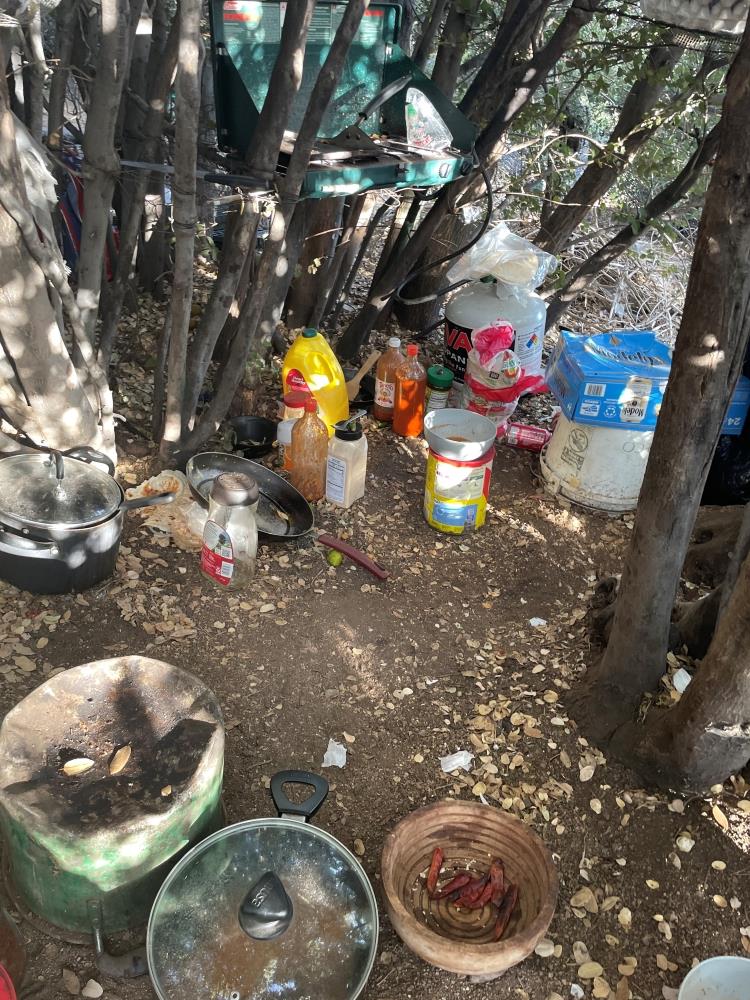 A makeshift kitchen at an illegal cannabis grow site in San Bernardino County. CDFW photo.
A makeshift kitchen at an illegal cannabis grow site in San Bernardino County. CDFW photo.
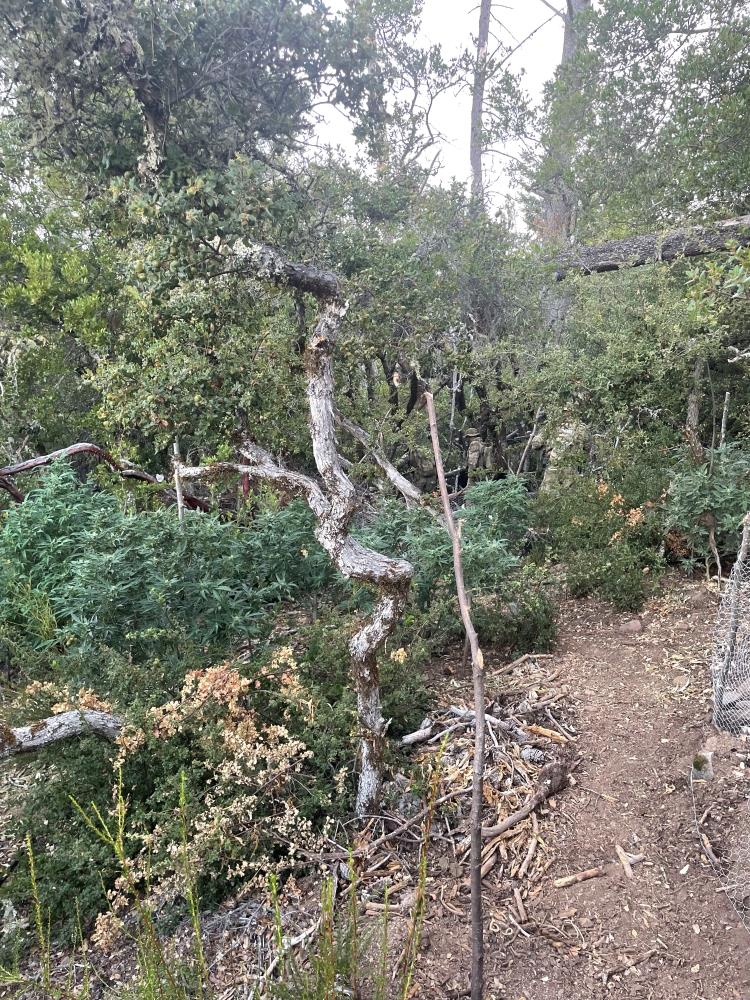 MET officers walking through an illegal cannabis grow site in Santa Cruz County. CDFW photo.
MET officers walking through an illegal cannabis grow site in Santa Cruz County. CDFW photo.
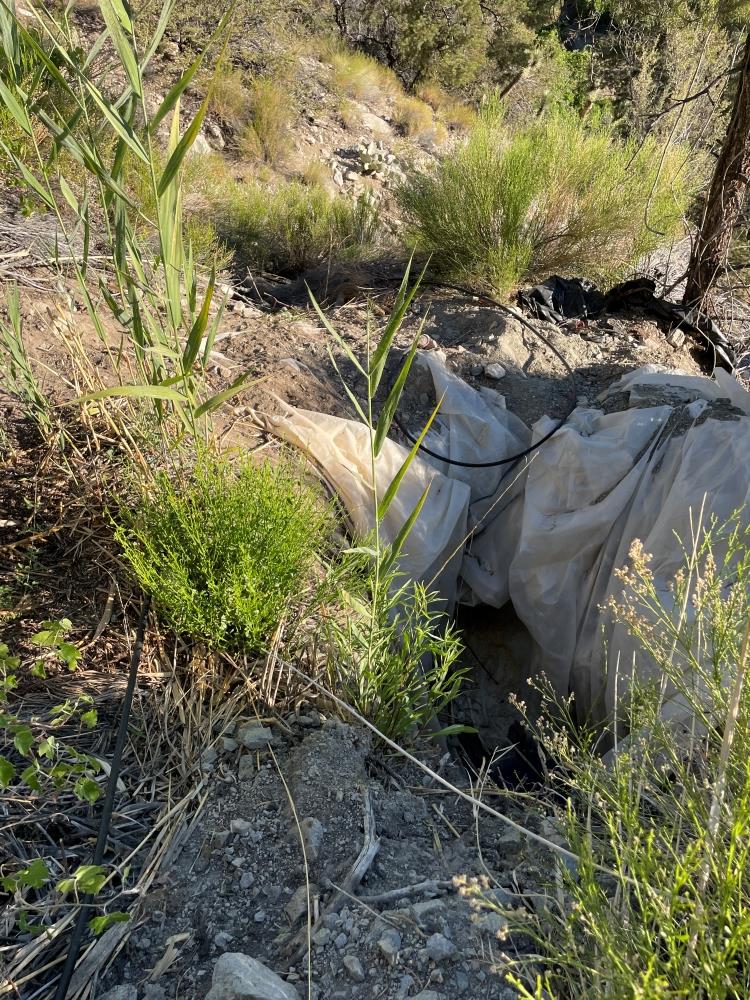 A water storage impoundment—a hole in the ground lined with plastic, where water from a natural spring was diverted with hosing—for illegal cannabis grow operations at a site in San Bernardino County. CDFW photo.
A water storage impoundment—a hole in the ground lined with plastic, where water from a natural spring was diverted with hosing—for illegal cannabis grow operations at a site in San Bernardino County. CDFW photo.
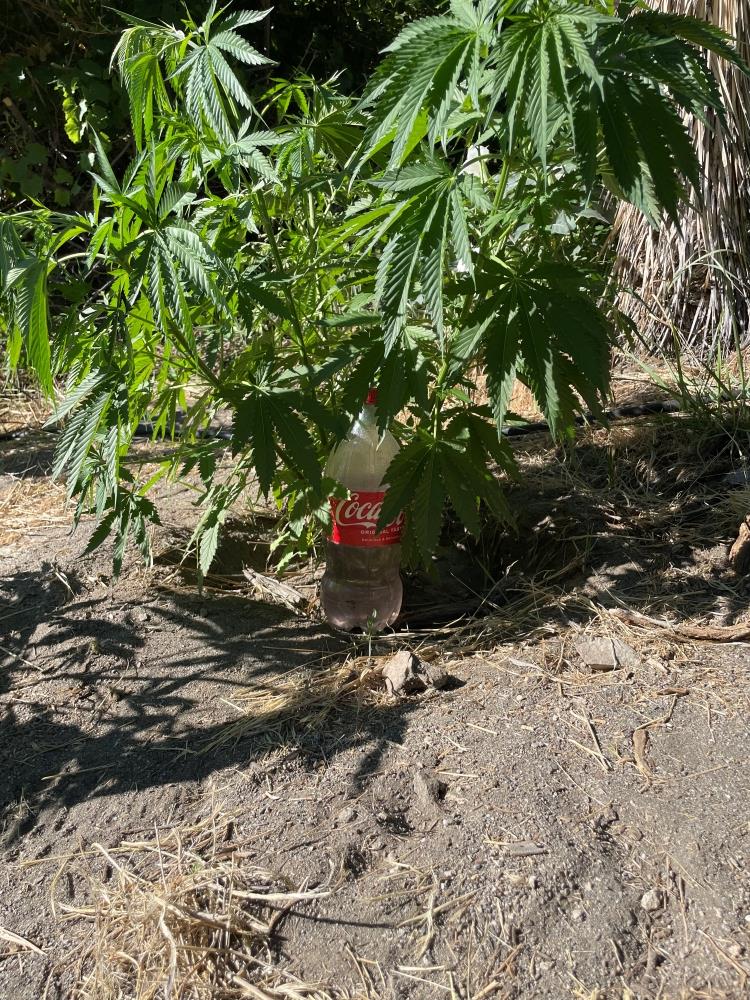 At this illegal cannabis grow site in San Bernardino County, officers removed more than 1,300 pounds of trash, including this soda bottle, which officers suspected contained a toxic pesticide. The bottle’s contents were tested at an independent lab, which confirmed the bottle contained carbofuran. Plants collected as evidence at this site also tested positive for carbofuran. CDFW photo.
At this illegal cannabis grow site in San Bernardino County, officers removed more than 1,300 pounds of trash, including this soda bottle, which officers suspected contained a toxic pesticide. The bottle’s contents were tested at an independent lab, which confirmed the bottle contained carbofuran. Plants collected as evidence at this site also tested positive for carbofuran. CDFW photo.
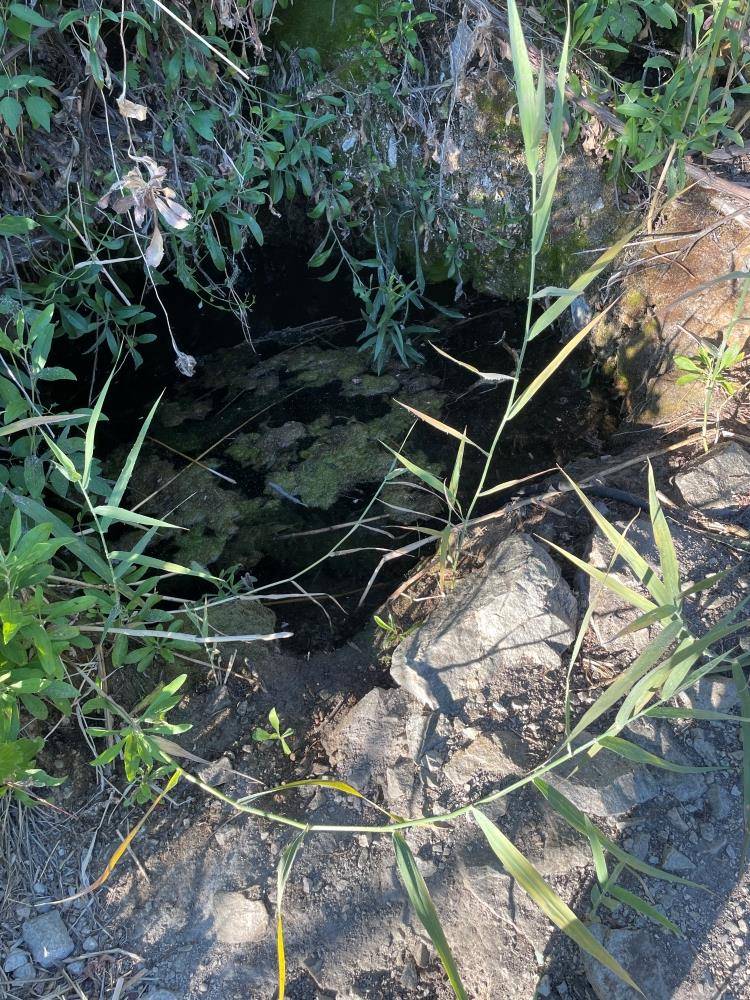 Water from this natural spring was diverted for illegal cannabis grow operations at a site in San Bernardino County. CDFW photo.
Water from this natural spring was diverted for illegal cannabis grow operations at a site in San Bernardino County. CDFW photo.
What you need to know: CDFW’s Marijuana Enforcement Team conducted enforcement operations at six publicly accessible sites across California in July and August where hidden cannabis grow operations were negatively impacting natural resources.
Sacramento, CA — During July and August, a specialized law enforcement team at the California Department of Fish and Wildlife (CDFW) conducted raids on six illegal cannabis grow sites hidden within sensitive habitats and watersheds in five California counties.
CDFW’s Marijuana Enforcement Team (MET) led enforcement operations at illegal grow sites in Los Angeles, San Bernardino and San Mateo counties; supported an operation led by other CDFW Cannabis Enforcement Program officers at an illegal grow site in Santa Cruz County; and supported operations jointly led by CDFW’s Cannabis Enforcement Program and the U.S. Department of Agriculture Forest Service at an illegal grow site in Tehama County. The enforcement operations took place on lands the public can access—including Forest Service property; municipal water district property; and large, underdeveloped private properties—and were part of CDFW’s ongoing work to help dismantle the illegal cannabis market in California, which contributes to a wide range of environmental impacts and risks to the public.
“Our water is a delicately balanced system that enables communities to thrive and the environment to flourish. Illegal cannabis grows threaten that balance. If you violate the law, we will do everything in our power to hold you accountable,” said Governor Gavin Newsom.
“Nearby communities and fish and wildlife depend on clean water from these watersheds,” said CDFW Director Charlton H. Bonham. “When criminals steal or destroy the natural resources that support California’s extraordinary biodiversity, we are committed to stopping them—and we have the teams in place to do that, no matter how far into the wilderness they try to hide their operations.”
Based on evidence collected at all six sites and on interviews with apprehended suspects, MET officers concluded that transnational criminal organizations operated the grows. These organizations and their affiliated gangs often ignore or are unaware of the damage they cause to natural resources—for example, they use fertilizers and pesticides that contaminate soil and water and divert water essential for fish and wildlife. Because such groups have a history of violence and armed encounters with law enforcement at illegal grow sites, enforcement operations involving them remain dangerous.
With support from other CDFW Cannabis Enforcement Program officers, the multiagency Eradication and Prevention of Illicit Cannabis (EPIC) program and local allied agencies, MET officers apprehended eight suspects during the six operations and arrested them for crimes including:
- Depositing hazardous substances on land belonging to another.
- Cannabis cultivation resulting in pollution of waters of the state.
- Cannabis cultivation causing substantial environmental harm to public lands.
- Cultivation of cannabis with unlawful take.
- Resisting arrest.
The officers also:
- Seized and removed partially used bottles of highly toxic substances carbofuran and methamidophos, pesticides banned for usage in the United States due to health and safety hazards.
- Eradicated 21,000 cannabis plants, which CDFW estimates would have used up to 9.5 million gallons of water over their growing cycles if they had not been eradicated.
- Restored water flow at five locations where water had been illegally diverted.
- Removed more than 2,300 pounds of trash and infrastructure and staged the sites for future cleanup.
- Destroyed more than 150 pounds of cannabis that had been processed for sale.
- Seized two illegally possessed firearms.
One of the suspects at a site where a firearm was recovered attempted to flee when MET officers announced themselves as police officers. He was apprehended by one of MET’s K-9s.
“I’m proud of our MET officers and the work they do to protect our natural resources and help keep the people of California safe,” said CDFW Chief of Enforcement Nathaniel Arnold. “This team works long days at a fast operational pace to locate illegal grow sites that criminal enterprises have intentionally hidden in locations that are difficult to access.”
Consisting of 10 officers spread throughout the state from its southern border with Mexico to its northern border with Oregon, MET is the only team within CDFW’s Cannabis Enforcement Program that specializes in conducting raids and apprehending suspects in clandestine grows run by transnational criminal organizations on public lands. The work is intense, often starting hours before dawn and going late into the night, and MET officers can be away from home for days or weeks at a time.
MET officers learned of three of the six sites they raided in July and August through reports from concerned citizens—in one case, a hunter scouting for deer. The public remains one of the best sources for reports of illegal cannabis cultivation activity on federal, state and county property. CDFW’s fact sheet “Report Illegal Cannabis Grows on Public Lands (PDF)” provides information about how to share tips confidentially through CalTIP (Californians Turn in Poachers and Polluters). To share a tip—24 hours a day, seven days a week—call (888) 334-2258 or send a text to 847411 (TIP411).
To learn more about CDFW’s role in helping to protect California’s natural resources while supporting the regulated cannabis cultivation industry, visit CDFW’s Cannabis Program online. To learn more about MET and its officers’ extensive training, see the section “More About CDFW’s Marijuana Enforcement Team” below.
More About CDFW’s Marijuana Enforcement Team
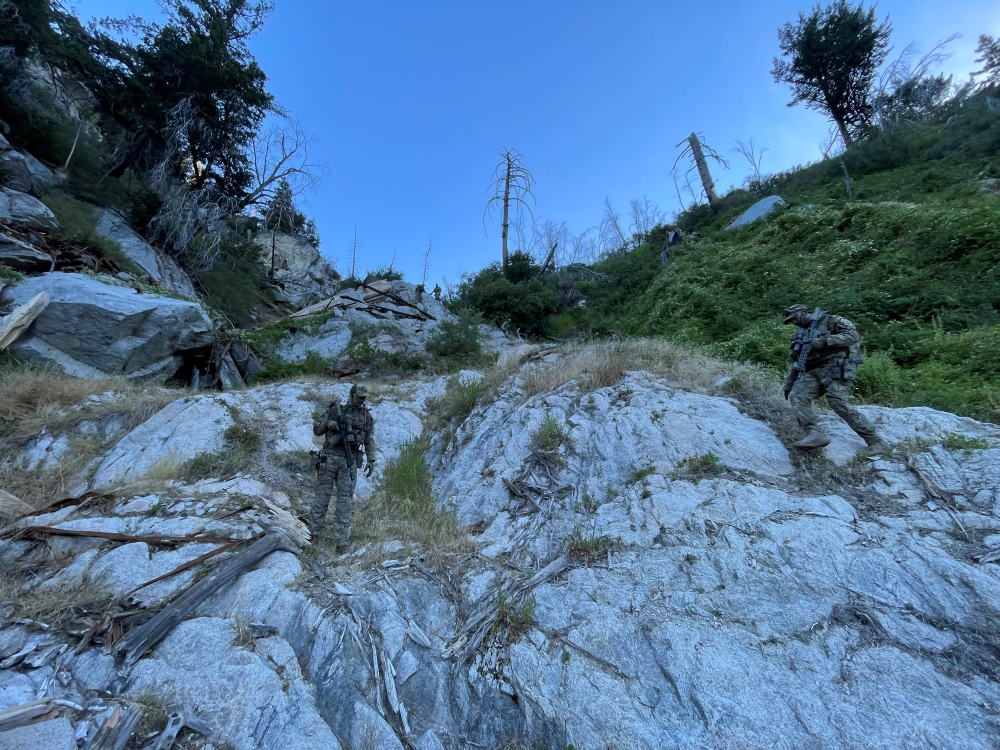 MET officers climbing down a steep cliff at dawn while investigating illegal cannabis cultivation in Los Angeles County. CDFW photo.
MET officers climbing down a steep cliff at dawn while investigating illegal cannabis cultivation in Los Angeles County. CDFW photo.
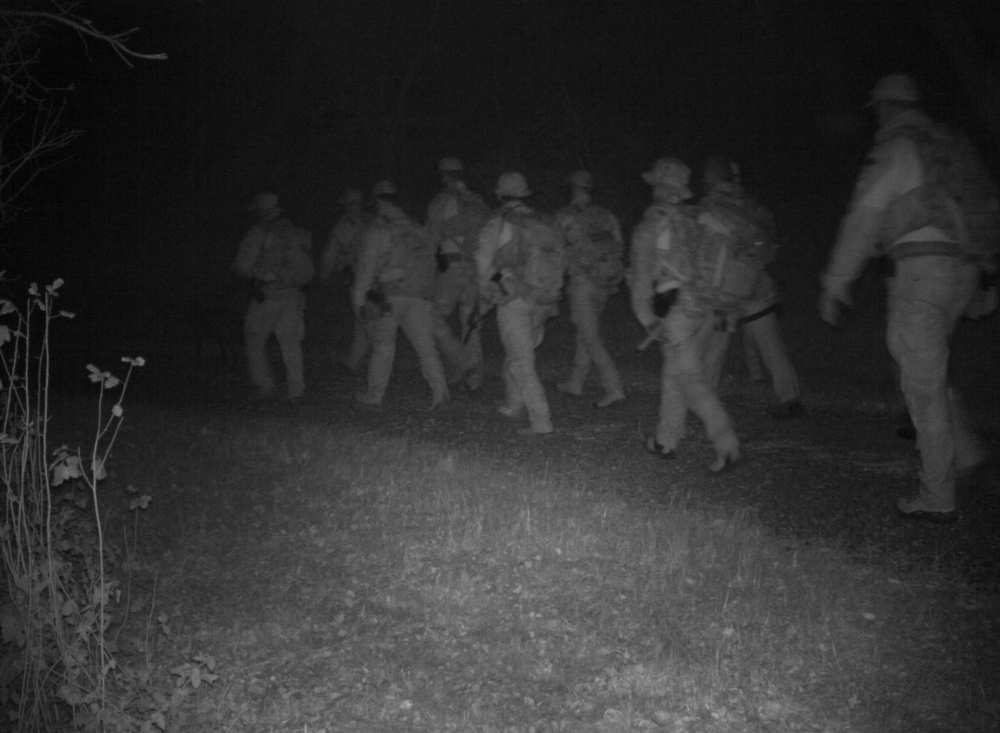 MET officers walking hours before dawn during one of their August 2025 operations. CDFW photo.
MET officers walking hours before dawn during one of their August 2025 operations. CDFW photo.
CDFW established its Marijuana Enforcement Team (MET) in 2014 as a special operations law enforcement team whose specific mission is to protect public safety and California natural resources that are threatened by illegal cannabis cultivation on public lands and trespass grows on large private lands. The team’s work spurred the development and expansion of CDFW’s overarching Cannabis Enforcement Program, which has eight other teams, focused primarily on enforcement operations at private property grow sites.
Officers must pass a rigorous selection process to obtain a position on MET. They train together for multiple days at least once a month, and they work operations together multiple times per month. All experienced MET officers have graduated from a special weapons and tactics (SWAT) school, similar to traditional law enforcement officers on city and local SWAT teams. Some MET officers are certified snipers, some are certified K-9 handlers, and most are instructors on subjects such as firearms and defensive tactics. However, unlike many municipal SWAT teams, CDFW’s MET officers also specialize in operating in rural environments and have a background in the traditional wildlife officer work that laid the foundation for MET activities. They have extensive training and experience in tracking, fieldcraft, land navigation and rural tactics. Because they work in remote areas far from any assistance, they are required to have higher levels of knowledge in survival and medical skills than most law enforcement officers.
During operations, MET officers are often required to hike several hours to their target locations in steep, mountainous terrain at night and in triple-digit heat during the day while carrying 50 pounds of gear. The locations MET officers investigate are so remote that suspects being transported to jails for processing often must be removed by helicopter. Because MET is responsible for executing CDFW’s higher-risk operations, MET officers travel extensively, often with little notice.
###
Media contact:
Sarah Sol, CDFW Office of Communications, Education and Outreach, (916) 207-7891